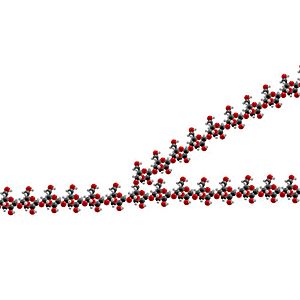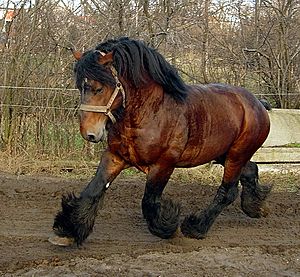Equine polysaccharide storage myopathy facts for kids
PSSM (which stands for Polysaccharide Storage Myopathy) is a health problem horses can inherit. It's a type of glycogen storage disease that makes their muscles stiff and sore, especially after exercise. It affects many horse breeds, like American Quarter Horses, Paint Horses, Warmbloods, and some heavy horse breeds. There's no cure for PSSM, but horses can live well with it if they have the right diet and exercise. There are two main types: Type 1 PSSM and Type 2 PSSM.
Contents
What is Glycogen and PSSM?
Imagine your horse's body needs energy. It gets this energy from glucose, which is a type of sugar. When there's extra glucose, the body stores it as something called glycogen. Glycogen is like a super-sized energy bank account. It's important for keeping blood sugar levels steady and for giving energy to muscles, especially during exercise.
In horses with PSSM, there's a problem with how their bodies store or use this glycogen. It's like their energy bank account isn't working quite right, leading to too much glycogen building up in their muscles, or the glycogen isn't the right kind. This can cause muscle problems.
There are different ways this problem can happen:
- Type 1 PSSM: This is caused by a specific change in a horse's genes (called GSY1). This change makes the horse's body store too much glycogen in its muscles. The glycogen also forms in a way that makes it hard for the body to use it properly. Some horses with Type 1 PSSM might also be extra sensitive to insulin, which means their muscles take up even more sugar, adding to the problem.
- Glycogen Branching Enzyme Deficiency: This is a very serious problem caused by another gene change (in the GBE1 gene). It means the horse can't make enough of a special enzyme needed to build glycogen correctly. The glycogen that is made is very hard to break down. This condition is usually seen in young Quarter Horse foals and is often fatal.
- Type 2 PSSM: This is a category for other types of PSSM where horses have too much glycogen in their muscles, but it's not caused by the gene changes seen in Type 1 PSSM or Glycogen Branching Enzyme Deficiency. Scientists are still learning more about Type 2 PSSM.
Which Horses Get PSSM?
PSSM is most common in American Quarter Horses and their relatives, like Paint Horses and Appaloosas. It's also often seen in Draft horse breeds, especially Belgian Drafts and Percherons, and in Warmblood breeds. For example, about 36 out of every 100 Belgian Draft horses might have PSSM.
Other breeds that can get PSSM include Arabians, Lipizzaners, Morgans, Mustangs, Thoroughbreds, and many others.
Scientists think that the gene change causing Type 1 PSSM might have actually helped horses in the past, especially those that worked hard and didn't always have the best food. It made them "thrifty" and good at storing energy. But now, for horses that don't work as hard or eat diets high in sugars, this gene can cause problems.
Type 1 PSSM is more common in Quarter Horses and draft breeds. Type 2 PSSM is seen more often in other breeds, including Warmbloods. Both male and female horses can get PSSM.
Signs Your Horse Might Have PSSM
Horses with Type 1 PSSM usually look normal when they are resting. But when they start to do even light exercise, they might show signs of "tying up." This means their muscles become stiff and sore.
Common signs of PSSM include:
- Taking short, stiff steps.
- Muscles feeling very firm.
- Sweating a lot.
- Showing pain or not wanting to move.
- Problems with how they walk.
- Shifting lameness (limping on different legs).
- Muscle weakness, which can sometimes make it hard for them to stand up.
- Pain that looks like colic (belly pain).
- Muscle twitching, shrinking, or stiffness, especially in their hindquarters.
These signs often first appear when a horse starts training as a young animal. Even young foals (around one month old) can show muscle changes if they have PSSM. They might also have higher levels of an enzyme called creatine kinase (CK) in their blood, which goes up when muscles are damaged.
Sometimes, if a horse with PSSM gets sick (like with a cold or stomach bug), their muscles can get very damaged even without exercise. Horses with PSSM often have slightly high CK levels even when resting, which helps vets tell PSSM apart from other muscle problems.
Why Signs Can Be Different
Not all horses with PSSM show the same signs. Some might have no signs at all, while others have mild problems that don't stop them from being athletic. But some horses can have very severe signs that prevent them from exercising much. In rare cases, horses can even die from severe muscle damage.
Scientists are still trying to understand why the signs vary so much. Things like a horse's diet and how much they exercise can make a big difference. Also, whether a horse has one or two copies of the changed GSY1 gene, and if they have other gene changes, can affect how severe their PSSM is.
For example, a gene called RYR1, which helps control calcium in muscle cells, can make PSSM worse if it's also changed. Horses with both the GSY1 and RYR1 changes are more likely to have severe PSSM, more muscle damage, and worse exercise problems.
Another gene change, SCNA4, causes a condition called hyperkalemic periodic paralysis (HYPP). If a horse has both the GSY1 and SCNA4 gene changes, they can have very severe muscle damage if they have an HYPP attack and can't stand up.
How Vets Diagnose PSSM
To find out if a horse has Type 1 PSSM, vets can do a genetic test using a blood sample or even hair. This test is easy and doesn't hurt the horse. However, for breeds where Type 2 PSSM is more common, this test might not be enough.
If a horse shows signs of PSSM but tests negative for the Type 1 gene change, the vet might recommend a muscle biopsy. This is where a small piece of muscle is taken from the horse's hind leg. The muscle sample is then looked at under a microscope. Special stains can show if there's too much glycogen or abnormal glycogen in the muscle. This is currently the only way to diagnose Type 2 PSSM.
Horses with Type 1 PSSM usually have 1.5 to 2 times the normal amount of glycogen in their muscles. Even though muscle damage can be seen in foals as young as one month old, it might take up to three years for the abnormal glycogen to build up enough to be clearly seen in a biopsy.
Managing PSSM with Diet and Exercise
Horses with PSSM have higher levels of glycogen in their muscles even when they are resting. When they exercise, their glycogen levels drop faster than in healthy horses. But once they stop exercising, their muscles make glycogen twice as fast as normal horses, which leads to the build-up.
Horses with PSSM, especially Quarter Horse types, are very good at taking sugar from their blood into their muscle cells. This means their muscles get a lot of sugar, which they then quickly turn into glycogen to store.
The good news is that PSSM can be managed very well! About half of horses improve a lot with just diet changes. If you combine diet changes with the right exercise, about 90% of horses will have few or no "tying up" episodes.
Diet for PSSM Horses
What a horse eats has a big impact on their PSSM signs. If PSSM horses eat diets high in "nonstructural carbohydrates" (NSC), like lots of sugar and starch, their muscles can get worse after exercise. NSC makes the body release more insulin, which then tells muscle cells to take in more sugar.
The best diet for horses with PSSM is usually:
- Low-starch: This means feeding less sugar and starch. This helps keep blood sugar and insulin levels low after eating, so less sugar goes into the muscle cells.
- High-fat: Adding healthy fats to the diet can encourage the horse's body to use fat for energy instead of sugar. This can help reduce the reliance on glycogen.
Horses with the most severe PSSM signs often show the biggest improvement on this type of diet. The diet needs to be balanced with the horse's body condition (how fat or thin they are) and how much they exercise. For example, an overweight horse might need to lose weight before adding extra fat to their diet. Generally, the diet should have less than 10% of its energy from NSC and 15-20% of its energy from fat.
Exercise for PSSM Horses
Horses with PSSM usually have fewer problems if their exercise is increased slowly over time. It's also very important to avoid long periods of stall rest. If a PSSM horse is kept in a stall for a long time and then exercised, they are much more likely to develop muscle stiffness and "tie up."
Interestingly, PSSM horses often have less muscle damage when they do short bursts of very intense exercise (like sprinting). However, they might get tired faster. They tend to have more muscle damage when they do lower-intensity exercise for a long time (like long trail rides), because their muscles might not get enough energy during these activities.



